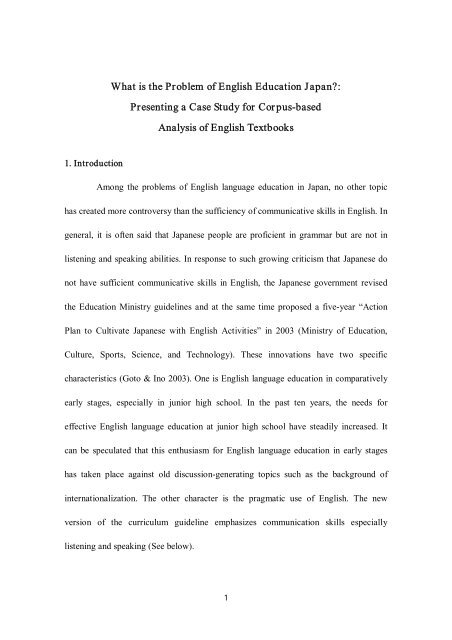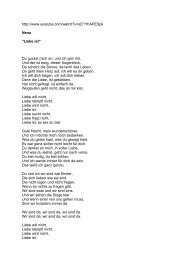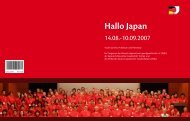What is the Problem of English Education Japan?: Presenting a ...
What is the Problem of English Education Japan?: Presenting a ...
What is the Problem of English Education Japan?: Presenting a ...
Create successful ePaper yourself
Turn your PDF publications into a flip-book with our unique Google optimized e-Paper software.
<strong>What</strong> <strong>is</strong> <strong>the</strong> <strong>Problem</strong> <strong>of</strong> Engl<strong>is</strong>h <strong>Education</strong> <strong>Japan</strong>:<br />
<strong>Presenting</strong> a Case Study for Cor pus-based<br />
Analys<strong>is</strong> <strong>of</strong> Engl<strong>is</strong>h Textbooks<br />
1. Introduction<br />
Among <strong>the</strong> problems <strong>of</strong> Engl<strong>is</strong>h language education in <strong>Japan</strong>, no o<strong>the</strong>r topic<br />
has created more controversy than <strong>the</strong> sufficiency <strong>of</strong> communicative skills in Engl<strong>is</strong>h. In<br />
general, it <strong>is</strong> <strong>of</strong>ten said that <strong>Japan</strong>ese people are pr<strong>of</strong>icient in grammar but are not in<br />
l<strong>is</strong>tening and speaking abilities. In response to such growing critic<strong>is</strong>m that <strong>Japan</strong>ese do<br />
not have sufficient communicative skills in Engl<strong>is</strong>h, <strong>the</strong> <strong>Japan</strong>ese government rev<strong>is</strong>ed<br />
<strong>the</strong> <strong>Education</strong> Min<strong>is</strong>try guidelines and at <strong>the</strong> same time proposed a five-year “Action<br />
Plan to Cultivate <strong>Japan</strong>ese with Engl<strong>is</strong>h Activities” in 2003 (Min<strong>is</strong>try <strong>of</strong> <strong>Education</strong>,<br />
Culture, Sports, Science, and Technology). These innovations have two specific<br />
character<strong>is</strong>tics (Goto & Ino 2003). One <strong>is</strong> Engl<strong>is</strong>h language education in comparatively<br />
early stages, especially in junior high school. In <strong>the</strong> past ten years, <strong>the</strong> needs for<br />
effective Engl<strong>is</strong>h language education at junior high school have steadily increased. It<br />
can be speculated that th<strong>is</strong> enthusiasm for Engl<strong>is</strong>h language education in early stages<br />
has taken place against old d<strong>is</strong>cussion-generating topics such as <strong>the</strong> background <strong>of</strong><br />
internationalization. The o<strong>the</strong>r character <strong>is</strong> <strong>the</strong> pragmatic use <strong>of</strong> Engl<strong>is</strong>h. The new<br />
version <strong>of</strong> <strong>the</strong> curriculum guideline emphasizes communication skills especially<br />
l<strong>is</strong>tening and speaking (See below).<br />
1
THE COURSE OF STUDY FOR FOREIGN LANGUAGES<br />
Ⅰ. Overall Objectives<br />
To develop students’ basic practical communication abilities such as l<strong>is</strong>tening<br />
and speaking, deepening <strong>the</strong> understanding <strong>of</strong> language and culture, and fostering a<br />
positive attitude toward communication through foreign languages.<br />
(Curriculum guideline <strong>of</strong> <strong>the</strong> MEXT 2003)<br />
Engl<strong>is</strong>h has played a central role as <strong>the</strong> common international language in<br />
linking people who have different mo<strong>the</strong>r tongues. For children living in <strong>the</strong> 21st<br />
century, it <strong>is</strong> essential for <strong>the</strong>m to acquire communication abilities in Engl<strong>is</strong>h as a<br />
common international language.<br />
(Action Plan to Cultivate <strong>Japan</strong>ese with Engl<strong>is</strong>h Activities 2003)<br />
As a result <strong>of</strong> <strong>the</strong>se innovative trends toward pragmatic Engl<strong>is</strong>h education at an<br />
early stage, all Engl<strong>is</strong>h textbooks for junior high school students were rev<strong>is</strong>ed in 2006.<br />
Newly edited versions put more focus on communicative skills than <strong>the</strong> old ones.<br />
The aim <strong>of</strong> th<strong>is</strong> paper <strong>is</strong> to analyze each Engl<strong>is</strong>h textbook used in <strong>Japan</strong>ese<br />
junior high schools and to demonstrate how much <strong>the</strong> current <strong>Japan</strong>ese reforms in<br />
Engl<strong>is</strong>h language education have an influence on actual education, comparing Engl<strong>is</strong>h<br />
written in textbooks with Engl<strong>is</strong>h used in actual scenes. At <strong>the</strong> end, th<strong>is</strong> paper will<br />
present better guidance plan <strong>of</strong> teaching Engl<strong>is</strong>h to <strong>Japan</strong>ese-speaking people.<br />
2
2. Why are <strong>Japan</strong>ese not good at communication in Engl<strong>is</strong>h<br />
It <strong>is</strong> <strong>of</strong>ten said that <strong>Japan</strong>ese people are not good at communication in Engl<strong>is</strong>h.<br />
Many <strong>Japan</strong>ese students cannot speak Engl<strong>is</strong>h well, even though <strong>the</strong>y achieved high<br />
scores on grammar tests. According to <strong>the</strong> TOEFL test score data in 2003, <strong>Japan</strong>ese<br />
average scores are well below <strong>the</strong> average <strong>of</strong> all countries in each section except for <strong>the</strong><br />
grammar section. In addition, total average score ranking <strong>of</strong> <strong>Japan</strong>ese <strong>is</strong> 248 out <strong>of</strong> 259<br />
all countries.<br />
How could such a thing happen There are three reasons. The first reason <strong>is</strong> <strong>the</strong><br />
popularization <strong>of</strong> <strong>the</strong> TOEFL test in <strong>Japan</strong> (Goto & Ino 2003). In o<strong>the</strong>r words, a wide<br />
range <strong>of</strong> people take <strong>the</strong> TOEFL test in <strong>Japan</strong>, while in some countries, only a limited<br />
number <strong>of</strong> elite-track people can take th<strong>is</strong> test. For example, <strong>the</strong> number <strong>of</strong> <strong>Japan</strong>ese<br />
applicants for <strong>the</strong> TOEFL CBT in 2003 was 81,749 while that <strong>of</strong> China was 24,075<br />
(Refer to <strong>the</strong> table1).<br />
Table1. TEFL CBT Total Score <strong>of</strong> Asian Countries in 2003<br />
Country The number <strong>of</strong> applicants Score<br />
<strong>Japan</strong> 81,749 188<br />
Singapore 387 254<br />
India 62,151 246<br />
Pak<strong>is</strong>tan 3,272 233<br />
Philippines 16,920 229<br />
Malaysia 2,626 226<br />
Kyrgyzstan 178 222<br />
China 24,075 213<br />
South Korea 86,188 209<br />
3
The second reason <strong>is</strong> <strong>the</strong> lack <strong>of</strong> similarity between <strong>Japan</strong>ese language and<br />
Engl<strong>is</strong>h language. Because <strong>Japan</strong>ese language has different lingu<strong>is</strong>tic roots from Engl<strong>is</strong>h,<br />
it <strong>is</strong> more difficult for <strong>Japan</strong>ese-speaking people to learn Engl<strong>is</strong>h than people who speak<br />
a language <strong>of</strong> Indo-European language family. In fact, <strong>the</strong> TOEFL scores in European<br />
countries are far higher than those <strong>of</strong> Asian countries.<br />
The third reason <strong>is</strong> <strong>the</strong> Engl<strong>is</strong>h education system in <strong>Japan</strong>. Many schools in<br />
<strong>Japan</strong> put an emphas<strong>is</strong> only on Engl<strong>is</strong>h grammar. On <strong>the</strong> o<strong>the</strong>r hand, most countries<br />
throughout <strong>the</strong> world focus not only on grammatical skills but also on communicative<br />
skills. It <strong>is</strong> because Engl<strong>is</strong>h has played a central role as <strong>the</strong> common international<br />
language in linking people who have different mo<strong>the</strong>r tongues.<br />
3. Engl<strong>is</strong>h textbooks in <strong>Japan</strong><br />
In such a situation, <strong>the</strong> enthusiasm for Engl<strong>is</strong>h language education focused on<br />
communicative skills has grown, and six versions <strong>of</strong> Engl<strong>is</strong>h textbooks for secondary<br />
school education were publ<strong>is</strong>hed in <strong>Japan</strong> in 2006. All six versions were rev<strong>is</strong>ed in 2006<br />
in response to a series <strong>of</strong> innovation <strong>of</strong> Engl<strong>is</strong>h language education as previously noted.<br />
Each school has sole d<strong>is</strong>cretion on which textbook to use for instruction. In th<strong>is</strong> paper,<br />
all <strong>the</strong> textbooks are investigated, but <strong>the</strong> objects <strong>of</strong> <strong>the</strong> main analys<strong>is</strong> are newly rev<strong>is</strong>ed<br />
versions.<br />
Table2. Previous versions (2003)<br />
THE TITLE OF TEXTBOOK<br />
IN JAPAN<br />
PUBLISHER CIRCULATION SCHOOLS<br />
USING (%)<br />
New Horizon Tokyo-shoseki 1,510,517 40,8<br />
SunShine Engl<strong>is</strong>h Kairyudo-shuppan 828,463 22,4<br />
New Crown Sanseido 826,363 22,3<br />
Total Engl<strong>is</strong>h Gakkou-tosho 297,194 8,0<br />
4
One World Kyouiku-shuppan 142,812 3,9<br />
Columbus 21 Mitsumura-tosho 78,044 2,1<br />
Total active.comm Shubunkan 17,943 0,5<br />
Table3. New edited versions (2006)<br />
THE TITLE OF TEXTBOOK<br />
IN JAPAN<br />
PUBLISHER CIRCYLATION SCHOOLS<br />
USING (%)<br />
New Horizon Tokyo-shoseki 1,575,372 42,5<br />
SunShine Engl<strong>is</strong>h Kairyudo-shuppan 802,856 21,0<br />
New Crown Sanseido 761,139 20,5<br />
Total Engl<strong>is</strong>h Gakkou-tosho 323,054 8,7<br />
One World Kyouiku-shuppan 177,664 4,8<br />
Columbus 21 Mitsumura-tosho 69,040 1,9<br />
Total active.comm Shubunkan 0 0<br />
4. Methodology<br />
4.1. Corpus-based analys<strong>is</strong><br />
Corpus, a large body <strong>of</strong> naturally occurring computer-readable texts or<br />
text-extracts (Leech 1992) will be used in th<strong>is</strong> research. The corpus (plural: corpora) can<br />
be defined as a body or collection <strong>of</strong> lingu<strong>is</strong>tic data for use in scholarship and research<br />
(Leech 1992). Many lingu<strong>is</strong>ts have used corpora in <strong>the</strong>ir lingu<strong>is</strong>tic research, and have<br />
defined what a corpus <strong>is</strong> <strong>of</strong> <strong>the</strong>ir own accord. According to Franc<strong>is</strong> (1982), <strong>the</strong> founder<br />
<strong>of</strong> corpus lingu<strong>is</strong>tics, a corpus <strong>is</strong> a collection <strong>of</strong> texts assumed to be representative <strong>of</strong> a<br />
given language, dialect, or o<strong>the</strong>r subset <strong>of</strong> a language to be used for lingu<strong>is</strong>tic analys<strong>is</strong>.<br />
O<strong>the</strong>r lingu<strong>is</strong>ts, Johansson (1991) also said that a corpus <strong>is</strong> a body <strong>of</strong> texts put toge<strong>the</strong>r<br />
in principled way, <strong>of</strong>ten for <strong>the</strong> purposes <strong>of</strong> lingu<strong>is</strong>tic research. In th<strong>is</strong> analys<strong>is</strong>, <strong>the</strong> most<br />
<strong>of</strong>t-quoted Leech and Fligelstone’s following definition <strong>is</strong> adopted.<br />
5
Computer corpora are, especially, bodies <strong>of</strong> natural language material (whole<br />
texts, samples <strong>of</strong> texts, or sometimes unconnected sentences) which are stored in<br />
machine readable form. … It should be added that computer corpora are rarely<br />
haphazard collections <strong>of</strong> textual material: <strong>the</strong>y are generally assembled with<br />
particular purposes in mind, and are <strong>of</strong>ten assumed to be (informally speaking)<br />
representative <strong>of</strong> some language or that type. (Leech and Fligelstone 1992)<br />
Moreover, according to Leech (1992), <strong>the</strong> corpus-based analys<strong>is</strong> has following four<br />
character<strong>is</strong>tics.<br />
(1) Focus on lingu<strong>is</strong>tic performance, ra<strong>the</strong>r than competence<br />
(2) Focus on lingu<strong>is</strong>tic description, ra<strong>the</strong>r than lingu<strong>is</strong>tic universals<br />
(3) Focus on quantitative, as well as qualitative models <strong>of</strong> language<br />
(4) Focus on a more empiric<strong>is</strong>t, ra<strong>the</strong>r than rational<strong>is</strong>t view <strong>of</strong> scientific inquiry<br />
In th<strong>is</strong> research, we will use two corpora and compare <strong>the</strong>m in terms <strong>of</strong> <strong>the</strong><br />
occurrence frequency <strong>of</strong> auxiliary modals, for modality <strong>is</strong> one <strong>of</strong> <strong>the</strong> most difficult<br />
concepts for <strong>Japan</strong>ese-speaking Engl<strong>is</strong>h leaner (Murcia & Freeman 2004).<br />
4.2. Brit<strong>is</strong>h National Corpus<br />
One <strong>of</strong> <strong>the</strong> corpora used in th<strong>is</strong> research <strong>is</strong> <strong>the</strong> Brit<strong>is</strong>h National Corpus (BNC).<br />
It <strong>is</strong> a 100-million-word text corpus containing samples <strong>of</strong> written and spoken Engl<strong>is</strong>h<br />
from a wide range <strong>of</strong> sources. It can be divided into two parts: one <strong>is</strong> <strong>the</strong> BNC-spoken<br />
and <strong>the</strong> o<strong>the</strong>r <strong>is</strong> <strong>the</strong> BNC-written. In th<strong>is</strong> case study, <strong>the</strong> former corpus will be used<br />
because <strong>the</strong> target <strong>of</strong> th<strong>is</strong> research <strong>is</strong> spoken Engl<strong>is</strong>h. The BNC-spoken contains<br />
transcriptions <strong>of</strong> spontaneous natural conversations made by members <strong>of</strong> <strong>the</strong> public.<br />
6
4.3. Engl<strong>is</strong>h textbook corpus<br />
On <strong>the</strong> o<strong>the</strong>r hand, in order to compare two types <strong>of</strong> Engl<strong>is</strong>h, Engl<strong>is</strong>h which <strong>is</strong><br />
spoken by native speakers and Engl<strong>is</strong>h taught in a classroom for instruction, corpora <strong>of</strong><br />
Engl<strong>is</strong>h textbooks are also needed. These Engl<strong>is</strong>h textbook corpora are scanned from<br />
each textbook and stored in machine-readable form. At th<strong>is</strong> time, <strong>the</strong> following<br />
textbooks used by 80% <strong>of</strong> all schools in <strong>Japan</strong> will be used for research.<br />
New Horizon 1-3 2006 Tokyo: Tokyo-shoseki<br />
Sunshine Engl<strong>is</strong>h 1-3. 2006 Tokyo: Kairyudo-shuppan<br />
New Crown 1-3 2006 Tokyo: Sanseido<br />
4.4. Compar<strong>is</strong>on <strong>of</strong> occurrence frequency <strong>of</strong> modal auxiliaries<br />
In th<strong>is</strong> research, <strong>the</strong> above-referenced corpora will be compared in terms <strong>of</strong> <strong>the</strong><br />
occurrence frequency <strong>of</strong> modal auxiliaries (*1). Th<strong>is</strong> <strong>is</strong> because modal auxiliaries are said<br />
to be one <strong>of</strong> <strong>the</strong> most difficult grammatical concepts for <strong>Japan</strong>ese to learn. According to<br />
Celce-Murcia & Larsen-Freeman (2003), <strong>the</strong> reason why <strong>Japan</strong>ese are not good at using<br />
modal auxiliaries <strong>is</strong> that <strong>Japan</strong>ese language does not have modal auxiliaries.<br />
Modal auxiliaries are among <strong>the</strong> more difficult structures ESL/EFL teachers to<br />
deal with. Some <strong>of</strong> your students, who have been told time and time again that<br />
present-tense verbs with third person singular subjects require an –s ending,<br />
overgeneralize th<strong>is</strong> rule to modals… Ano<strong>the</strong>r source <strong>of</strong> difficulty with <strong>the</strong> form <strong>of</strong><br />
modals, <strong>of</strong> course, may be your students’ native language(s). Not all languages have<br />
modal auxiliaries. (Celce-Murcia & Larsen-Freeman 2003)<br />
(*1) The stat<strong>is</strong>tical s<strong>of</strong>tware used in th<strong>is</strong> research <strong>is</strong> Oxford WordSmith Tools 4.0.<br />
7
Modal auxiliaries (will, would, can, could, should, must, may, shall, and o<strong>the</strong>rs)<br />
in four following corpora were compared.<br />
1. BNC (as a corpus <strong>of</strong> Engl<strong>is</strong>h spoken by native speakers)<br />
2. Textbook Corpus (a) New Horizon (as a corpus <strong>of</strong> Engl<strong>is</strong>h taught in a classroom)<br />
3. Textbook Corpus (b) Sunshine (as a corpus <strong>of</strong> Engl<strong>is</strong>h taught in a classroom)<br />
4. Textbook Corpus (c) New Crown (as a corpus <strong>of</strong> Engl<strong>is</strong>h taught in a classroom)<br />
5. Results & D<strong>is</strong>cussion<br />
As a result, <strong>the</strong>re are wide differences between <strong>the</strong> four corpora in terms <strong>of</strong> <strong>the</strong><br />
modal auxiliaries “would” and “can” (See accompanying table). The occurrence<br />
frequency <strong>of</strong> “would” in BNC <strong>is</strong> predominantly <strong>the</strong> highest <strong>of</strong> all corpora. The<br />
supposable cause <strong>is</strong> that Brit<strong>is</strong>h people prefer to use “would” in sentences (Chambers<br />
1995). On <strong>the</strong> o<strong>the</strong>r hand, <strong>the</strong> occurrence frequency <strong>of</strong> “can” in <strong>the</strong> three textbooks’<br />
corpora <strong>is</strong> higher than that in BNC. It <strong>is</strong> because <strong>the</strong> auxiliary verb “can” <strong>is</strong> taught over<br />
and over again in <strong>Japan</strong>ese junior high schools.<br />
Table4. The Occurrence Frequency <strong>of</strong> Modal Auxiliaries (% )<br />
45<br />
40<br />
35<br />
30<br />
25<br />
20<br />
15<br />
10<br />
5<br />
0<br />
wil<br />
would<br />
can<br />
could<br />
should<br />
must<br />
may<br />
shal<br />
o<strong>the</strong>rs<br />
BNC<br />
NH<br />
SS<br />
NC<br />
8
In addition, it <strong>is</strong> notable that “can” <strong>is</strong> taught in a classroom almost as a meaning<br />
<strong>of</strong> “ability”. According to Celce-Murcia & Larsen-Freeman’s grammar book (2003), <strong>the</strong><br />
functions <strong>of</strong> “can” can be divided into four parts.<br />
1) Ability for animate subjects e.g. I can speak Indonesian.<br />
2) Potentiality for inanimate subjects e.g. Th<strong>is</strong> business can be reorganized.<br />
3) Making general requests e.g. Can you help me with th<strong>is</strong> math problem<br />
4) Making requests for perm<strong>is</strong>sion e.g. Can I leave <strong>the</strong> room now<br />
In reference to th<strong>is</strong> classification, usages <strong>of</strong> “can” <strong>of</strong> two types <strong>of</strong> corpora (BNC and<br />
<strong>the</strong> textbooks’ corpora) are sorted into four different types noted above. Here are <strong>the</strong><br />
results.<br />
The Classification <strong>of</strong> “can” in BNC<br />
15%<br />
33%<br />
10%<br />
42%<br />
1.ablility<br />
2.potentiality<br />
3.generalrequests<br />
4.requestsforperm<strong>is</strong>sion<br />
The Classification <strong>of</strong> “can” in <strong>the</strong> textbooks’ corpora<br />
5% 5% 8% 1.ablility<br />
2.potentiality<br />
3.generalrequests<br />
4.requestsforperm<strong>is</strong>sion<br />
82%<br />
The d<strong>is</strong>tribution <strong>of</strong> <strong>the</strong> usage <strong>of</strong> “can” in BNC <strong>is</strong> well-balanced, while that in<br />
textbooks’ corpora places a d<strong>is</strong>proportionate emphas<strong>is</strong> on <strong>the</strong> usage <strong>of</strong> ability for<br />
animate subjects. Th<strong>is</strong> fact can be backed by data that Engl<strong>is</strong>h learners in <strong>Japan</strong> rarely<br />
9
use “can” for representing <strong>the</strong> potentiality for inanimate subjects (Huddleston & Pullum<br />
2005). Th<strong>is</strong> <strong>is</strong> one <strong>of</strong> <strong>the</strong> usages at which <strong>Japan</strong>ese are not as strong.<br />
On <strong>the</strong> whole, <strong>the</strong>se results tell us that <strong>the</strong>re <strong>is</strong> a sharp line drawn between<br />
Engl<strong>is</strong>h spoken by native speakers and Engl<strong>is</strong>h taught in <strong>the</strong> classroom. As long as <strong>the</strong>re<br />
are some differences between <strong>the</strong> two, it can be speculated that acqu<strong>is</strong>ition <strong>of</strong> proper<br />
communicative skills in Engl<strong>is</strong>h <strong>is</strong> almost impossible. <strong>What</strong> <strong>is</strong> needed now <strong>is</strong> to bring<br />
Engl<strong>is</strong>h in <strong>the</strong> classroom closer to Engl<strong>is</strong>h spoken by native speakers.<br />
6. Conclusion<br />
In <strong>the</strong> 21 st century, globalization in various fields has advanced rapidly, and<br />
each individual has more and more opportunities to participate in international activities.<br />
In such a situation, Engl<strong>is</strong>h has played a central role as an international language more<br />
than ever. Unfortunately, however, many <strong>Japan</strong>ese are restricted in <strong>the</strong>ir exchanges with<br />
foreigners due to <strong>the</strong>ir lack <strong>of</strong> sufficient communicative abilities in Engl<strong>is</strong>h. <strong>What</strong> <strong>is</strong><br />
needed now <strong>is</strong> improvement <strong>of</strong> Engl<strong>is</strong>h teaching methods and course materials.<br />
Th<strong>is</strong> study revealed that Engl<strong>is</strong>h taught in <strong>Japan</strong> <strong>is</strong> quite different from Engl<strong>is</strong>h<br />
spoken by native speakers in terms <strong>of</strong> modal auxiliaries. In order to enhance <strong>Japan</strong>ese<br />
people’s communicative skills in Engl<strong>is</strong>h, Engl<strong>is</strong>h in textbooks must be closer to<br />
practical Engl<strong>is</strong>h.<br />
10
References<br />
Celce-Murcia, Marianne. & Larsen-Freeman, Diane. 1999 .The Grammar Book.<br />
Heinle & Heinle: pp137-155<br />
Chambers,J.K.1995. Sociolingu<strong>is</strong>tic <strong>the</strong>ory. Lingu<strong>is</strong>tic variation and its social<br />
significance. Oxford: Blackwell.<br />
Franc<strong>is</strong>, W. N. 1982. “<strong>Problem</strong>s <strong>of</strong> assembling and computerizing <strong>of</strong> large corpora”.<br />
In; Johansson (ed.) pp. 7-24.<br />
Goto, Yuko Butler. & Iino, Masakazu. 2005.‘Current <strong>Japan</strong>ese Performs in Engl<strong>is</strong>h<br />
Language <strong>Education</strong>: The 2003 “Action Plan” ’Language Policy (2005)<br />
4,25-45<br />
Huddleston, Rodney. & Pullum, Ge<strong>of</strong>frey K.2005. A Student’s Introduction to Engl<strong>is</strong>h<br />
Grammar. Cambridge UP: UK: pp53-58<br />
Johansson, S. 1991. “Computer Corpora in Engl<strong>is</strong>h Language Research.” In: S.<br />
Johansson & A.Stenstrom (eds.), Engl<strong>is</strong>h Computer Corpora, Selected Papers<br />
and Research Guide. Berlin: Mouton de Gruyter. pp.3-6.<br />
Kramsch, Claire. “Second Language Acqu<strong>is</strong>ition, Applied Lingu<strong>is</strong>tics, and <strong>the</strong> Teaching<br />
<strong>of</strong> Foreign Languages”: The Modern Language Journal,84, 2000. pp311-326<br />
Leech, G. 1992 “Corpus Processing”. In: W. Bright (ed.), International Encyclopedia in<br />
Lingu<strong>is</strong>tics, New York: Oxford UP.<br />
Leech, G. & S. Fligelstone. 1992. “Computer and Corpus Analys<strong>is</strong>”. In: C.S. Butler (ed.),<br />
Computers and Written Texts. Oxford: Blackwall. pp. 115-140.<br />
Sinclair,John.McH.2004 How to Use Corpora in Language Teaching. John<br />
Benjamins:Amsterdam pp185-199<br />
Smith, L.E. “Some D<strong>is</strong>tinctive Features <strong>of</strong> EIL vs. ESL in Engl<strong>is</strong>h Language<br />
<strong>Education</strong>.” In L.E. Smith(Ed.), Reading in International Language.1983.<br />
pp.13-20<br />
Brit<strong>is</strong>h National Corpus. 2007. 22. Nov. <br />
Free CLAWS WWW trial service. 2007. 21. Nov. <br />
MEXT Homepage. 2007. 21. Nov. <br />
The Oxford Text Archive. 2007. 22. Nov. <br />
TOEFL Test and Score Data Summary. 2007. 28. Nov.<br />
<br />
11
Textbooks<br />
Columbus 21. 2. 2003. Tokyo: Mitsumura-tosho<br />
New Crown.1-3. 2003. Tokyo: Sanseido<br />
New Horizon.1-3. 2003. Tokyo: Tokyo-shoseki<br />
One World.1-3. 2003. Tokyo: Kyoiku-shuppan<br />
Sunshine Engl<strong>is</strong>h. 1-3. 2003. Tokyo: Kairyudo-shuppan<br />
Total Engl<strong>is</strong>h. 1-3. 2003. Tokyo: Gakkou-tosho<br />
Columbus 21. 2. 2006. Tokyo: Mitsumura-tosho<br />
New Crown.1-3. 2006. Tokyo: Sanseido<br />
New Horizon.1-3. 2006. Tokyo: Tokyo-shoseki<br />
One World.1-3. 2006. Tokyo: Kyoiku-shuppan<br />
Sunshine Engl<strong>is</strong>h. 1-3. 2006. Tokyo: Kairyudo-shuppan<br />
Total Engl<strong>is</strong>h. 1-3. 2006. Tokyo: Gakkou-tosho<br />
12






